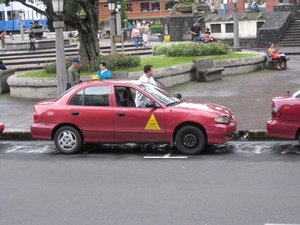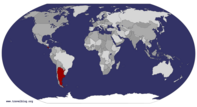Advertisement
Published: October 19th 2009

 Taxistas
Taxistas
Even cab drivers in downtown San Jose have caught on to the ghost-riding phenomenon.On the first day of Spanish class in Zapote, Costa Rica, Alisa and I were supposed to arrive a half hour early. So even though we are on vacation, we got up at 6:30 to adequately prepare for our first day. Alisa spent an hour and a half putting on makeup. I actually showered.
The mornings in Costa Rica are amazing. At 7 am it is an intensely sunny 75 degrees. Every morning. Our walk is so short we can hardly begin a conversation before entering COSI, which stands for Costa Rican Spanish Institute. My confusion in trying to figure out how that acronym works turned out to be some pretty heavy foreshadowing of things to come.
Alisa and I were buzzed through the gate by unknown eyes observing us from who knows where, in a building built to look like a boombox. As we walked into the impeccably clean, professional lobby, we were greeted by smiling women speaking English nice and slow. Alisa was asked to take a seat and I was beckoned into a woman’s office. I looked back at Alisa with a smile as I entered the threshold. It looked like we would have to fend for ourselves.
The moment I sat down the woman, whose name I now know is Silvia, began to speak quickly in Spanish. At first I caught a few words, and nodded my head as if I understood the rest until she stopped talking, after which she sat there staring at me expectantly. I then realized my first assessment had already begun. “Oh,” I said, finally catching on with a laugh, “I don’t speak any Spanish at all.”
Sylvia’s reaction was unexpected. For just a split second, so quickly I almost missed it, the corners of her mouth fell into a frown, and her eyes clouded over in surprise and confusion. She took a breath to compose herself, and the smile returned quickly. She said, “Oh, well okay then. You can go back in the lobby please.”
Alisa’s interview lasted five to ten minutes. As she chatted away in the Spanish she had picked up during a semester abroad in Mexico, I sat on the lobby bench excitedly wondering how many other beginners had enrolled this week. I imagined the laughter and friendships I had to look forward to, struggling to introduce each other to the class, and patting each other on the back. I couldn’t wait to impress the other novices with my secret knowledge of Mexicano swear words, which I planned on whispering when the teacher’s back was turned.
Sylvia gave us our room assignments, and together, Alisa and I climbed the stairs to the little classrooms on the second floor. It was still sunny and seventy, but from the second floor we could see clouds approaching from far away. Rain is never far away in Costa Rica.
Alisa waved goodbye and disappeared into the corner classroom, the one with a window and light, to be pleasantly surprised with her awesome class. Alisa is in an intermediate class with one other student, a twenty-one year old guy named Ross. All the students are twenty-one it seems. Alisa and Ross conversate with each other and their profesora with beauty and ease. As the days pass they laugh and joke, and make strides in their own language development at a pace that seems hard to sustain—yet somehow they manage it. Their days are spent juxtaposing culturas of Latinos in the Estados Unidos with Costa Ricans, and extolling the virtues of Spanish Literature.
Then there’s me.
Evidently all the other students from France, and Switzerland, and the USA, all studied a little bit of Spanish before moving to a Spanish speaking country. They had either studied it in high school, or University, or taken night classes at the local Junior College in preparation for their trip. Thinking about it now, it seems like the logical thing to do. You know, prepare.
Whoops.
As opposed to every other classroom full of emerging Spanish linguists, my classroom has just one student. Me. I guess there is no one else in any part of the world who had the audacity to move to Central America without any knowledge of the language. There are other beginner classes, but it seems I am the only one struggling with “I am,” and “I can.” I didn’t even take Spanish in high school. I took German. I think that point alone is what separates me from almost every American who travels to Latin America. At least they had three or four years of shitty public education under their belts.
To be fair, I thought that playing soccer with Mexicans my whole life would have provided me with a rudimentary knowledge of the language. On the soccer field my vocabulary is quite extensive. Pasala, centrala, linea, tirale, es tuya, and of course Gooooooooooooooooooooooool! With such strong building blocks I figured I was halfway there. Like my Soccer Spanish, I thought I’d simply add “ala” to the end of every word. “Book” would become “bookala”, “car” would be “carala,” and “them” would be “themala.” I figured there would be complications, but I thought I was ready for them. If it was small I’d add “ito” and if it was big I’d say “grande.” When frustrated, I would yell Chinga…, just like Alisa’s father had taught me, and I’d move forward. How hard could it be? I was ready to learn the language in the first week and expected to begin a novel in Spanish by La Navidad.
Instead I sit frustrating teacher after teacher with my ignorance.
Looking at it from the outside, Alisa is a bit amused. “You know honey, everyone else has the same teacher every week. How is it that you’ve gone through so many of them in such a short time?”
“I dunno. Maybe I should start showering again,” I say, remembering that first day of school—the one filled with such promise.
And Alisa is right. After two weeks I’ve already gone through two profesoras, and am working on a third. Alisa has had the same wonderful woman the entire time. I can even hear them giggling through the wall. We’ve gotten to know many of the other students, some of them having been at COSI longer than we have, and they too have had the same teacher every week. They are just as perplexed at my juggling tutors as I imagine Silvia and her staff are when putting their heads together to figure out what to do with me. COSI has their own curriculum, but even starting on page one I don’t seem to have the necessary background knowledge to complete most exercises. I think they might start ordering grade-school books just for El Americano.
To take a break from the frustration, and the studying, Alisa and I have taken to partying with our new friends. There are three students are from Switzerland, who each came here independently and don’t know each other. They each speak about six languages and are here to learn their seventh. There is also a Portuguese girl named Jessica who lives in Paris. She speaks Portuguese and French, and her Spanish is already very good because it is so similar to Portuguese. Luckily for me, they all speak English, except Jessica, but when foreigners say they don’t speak a language, that just means they don’t have a master’s degree in it—yet.
So we spend a lot of time in cabs, and learned very quickly that the first thing you do is buckle your seatbelt.
Driving in Costa Rica is an experience in itself. Everyone seems hell-bent on picking off pedestrians and ignoring traffic signals. A red light only means stop if there are cars coming from other directions. A stop sign doesn’t mean anything. Really. I almost wonder why the government spent money putting them up.
After putting on your seatbelt, the next thing you have to do is say to the driver, “La Maria, por favor.” This would seem to be a quiet reminder to the guy about the Virgin Mary, so he might spare our lives, and take it easy on the old lady you know he’s eyeing halfway across the street. But “La Maria” is the meter in the cab, and once you say it, he presses the big red triangle and the fare begins. If you don’t say anything, the cabbies reserve the right to charge you whatever they want.
Once on the road, the ticking fare is usually the least of our concerns. Juan, or whoever is driving, is never in a good mood, because by the first grade, the pedestrians have become adept at dodging taxis. So no matter how hard he tries, Juan never quite gets those third and fourth graders he veers toward at 160 kilometers an hour. He usually has to settle with a foreigner or two, and maybe a cripple. I imagine being a cripple must be twice as difficult in Costa Rica because the taxis are likely to make you one twice over.
In the Estados Unidos, when we almost get in an accident we are flustered and shaken, and whisper to one another, “That was a close one.” In Costa Rica, what we call close ones happen seven times in every single cab ride. I’m not joking. Seven.
Just yesterday Alisa and I were heading to Jeff and Margie’s house. I think Juan was trying his best to scare los Americanos in the back seat, and was succeeding nicely. On a two-lane highway, where the speeds of the cars vary from 30 to 110 miles per hour, we were stuck behind a car in the left lane and a motorcycle in the right lane. Without bothering to brake, Juan simply went between them, forcing both of them to part. And they were ready for it, as if they were expecting it. That ended up being the safest maneuver out of the seven “close ones.” I won’t write about the others because it makes me think about mortality too much.
More and more these cab rides remind me of my days in that windowless classroom. There are rules, but no one seems to follow them. There are traffic lanes everywhere, but where there are three lanes you find five rows of cars vying for position like on a NASCAR track.
In class, I certainly feel like I’m driving in circles.
You see, all verbs are conjugated exactly the same in Spanish. That is, except for irregular verbs, which there are like a million of. And if a noun ends in “a”, it is always feminine, except for exceptions, which there are like a million of. And I can’t help comparing these eccentricities of the language to the signs that require every driver to ALTO, except for when the drivers don’t—and there are a million of those bastards.
And the faces fly by the window so fast I barely remember what they look like, just like the muchas profesoras I’ve sped through.
But I walk into COSI every day at 7:55, ready to give it another try—even though I feel like I’m in the back seat of a Costa Rican cab without a seatbelt and I’ve forgotten to say “La Maria.” And although I know the rules of the road, every sign we come to is ignored, and everyone is driving way too fast.
But mostly I feel like a cripple, trying to make the far curb.
Advertisement
Tot: 0.066s; Tpl: 0.012s; cc: 7; qc: 46; dbt: 0.041s; 1; m:domysql w:travelblog (10.17.0.13); sld: 1;
; mem: 1.1mb








